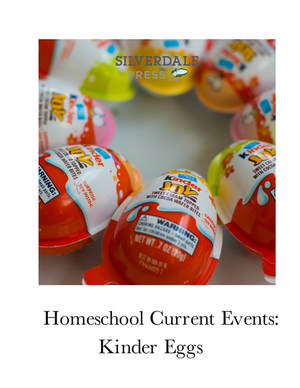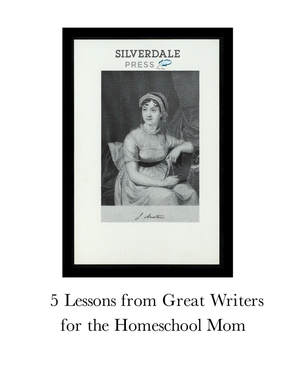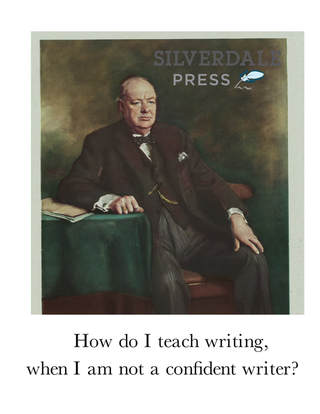 We have an Easter-themed Hot Chocolate and Current Events for you this week. There’s an iconic new treat on U.S. store shelves this Easter season. The Kinder Egg, popular in Europe, made its U.S. debut in 2018. But there’s a twist. Read this article from Fortune to find out the scoop. Map Points: Italy, Europe, U.S. Discussion Questions:
0 Comments
 6 Ways to Encourage Your Reluctant Writer Do you have a reluctant writer in your homeschool? If so, we have good news. No child is born a good or bad writer. Yes, every child has strengths and interests, and one child may be more eager to write than another. But writing well is a skill that can be learned, and writing regularly is a habit that can be cultivated. If you have a child who has a hard time putting pen to paper, here are 6 tactics to help you encourage and inspire the writing habit. 1. Provide a quiet space If your homeschool is like most, it is probably full of hustle, bustle, noise, and mess. That chaos can be a beautiful thing, but it can also discourage writing. Writers need to focus. To be productive, writers should have some uninterrupted time. So, if your child has writing assignment to tackle, try to minimize distractions. For example, you can settle your young writer in the den, while the rest of your family works around the kitchen table. 2. Provide an inviting space Your writing space matters. Start by asking your child where he or she would feel comfortable writing. Don’t assume it’s in the usual homeschool workspace. Maybe it is in a sunny spot on your porch or out in your garden. Maybe it is in a cozy leather arm chair. Maybe it is on a desk with a warm light and a pile of old books. Or try to create a new writing space from things you already have around the house. Do you have a teen? Drop him or her off at the coffee shop or library. Sometimes a change of scenery can start the creative juices flowing. 3. Give them freedom Children should have the freedom to write about what interests them. Is your child into technology? Give an assignment to compare and contrast computer brands. Does your child love cooking? Give an assignment to research cookery in modern England. Or simply tell them to write about what they want (their favorite dinner, a dream vacation, etc.) and set a word count. Tell them, You can write about anything, but you have to give me 250 words. 4. Provide interesting prompts If your child does better with structure, try giving some interesting prompts. Since everyone loves a good illustration, give them a picture to go along with the prompt. Show them a landscape painting and tell them to write a description of it. Take a photo from the newspaper, stripped of its caption, and ask them to write about what’s going on in the illustration. Show them a portrait of a famous person and ask them to write about what he or she was thinking during the portrait sitting. 5. Write more Remember that not every piece of writing has to go through the brainstorming, drafting, and revising stages. That can make writing seem like a long and boring process. Remember that writers get better at writing by writing. Yes, revising is important, but more important, for reluctant and professional writers alike, is simply putting words on a page. Be happy if the child is just writing; don’t expect every piece to be polished to perfection. 6. Share the passion for writing Help kids understand that writing is not just something they are slogging through for a school assignment. Make them see that writing can bring joy and satisfaction beyond the classroom. It can be a vocation or avocation. Some parents are passionate writers; others are not. If you are a passionate writer, share your blogging, journaling, or other writing with your child. If you are not a passionate writer, surround your reluctant writer with those who are. Invite a local journalist to come to your co-op. Take your child to the local library or bookstore to hear an author speak. Do you have mom blogger friend? Have her share her writing life with your child. In our soon-to-be-released writing curriculum, Persuasive Writing and Classical Rhetoric: Practicing the Habits of Great Writers, we aim to cultivate the writing habit in your child. All of the above tactics are covered in the curriculum. We have inspiring quotes and pro-tips, weekly writing assignments, and creative prompts with word counts. We help students explore their own interests, while they imitate the habits of great writers. We can’t wait to share it with you! According to the Wall Street Journal, the number of words and encouragements spoken to children is related to the development of verbal reasoning skills. Reading a newspaper to them can help so much with this! It never hurts to read a child something above his or her level. These are some of our motivations for putting on Hot Chocolate and Current Events for you each week.
This week, we're talking about the fall of American icon, Toys "R" Us. Click here to get the article. Then sit down to have a chat with your children, using these discussion questions:
 As a homeschool mom, you’ve probably perused dozens of homeschool self-help books, read countless how-to blog posts, and sought counsel from other moms—all in search of homeschooling wisdom. But did you know that some of the world’s greatest writers also have wisdom to impart to the homeschool mom? As the end of another school year draws nigh, here are 5 lessons great writers can teach you, whether things are going well, or you’re just ready to be done. 1. Zap clutter Great writing stylist William Strunk told writers to get rid of clutter. “Omit needless words!” Strunk wrote in his classic, The Elements of Style. Clutter is not just in our writing; it’s in our homeschool. It’s in that unorganized bin of second grade math tests, in the box of stray puzzle pieces, and on the shelves that store curriculum we never used. Take some advice from Will Strunk: if clutter is bogging down your homeschool, get rid of it. Omit needless stuff! 2. Everyone loves a story You know Abraham Lincoln as one of the greatest American presidents. But Lincoln was also a great storyteller. He learned the art of storytelling as a young man; he learned how to spin a good yarn from his father, who actually did not like books and learning. “That reminds me of a story,” Lincoln would often say. Storytelling lifted Lincoln's spirits and the spirits of those who heard his stories. If you are in the end-of-year homeschool doldrums, open up a good story and read aloud to your kids. Reading together helps make connections and memories. Stories will lift their spirits, just as they did for Lincoln and his listeners. 3. Awaken wonder Nature writer Rachel Carson wrote about how important it was for parents to awaken their children's sense of wonder. “I believe that for the child, and for the parents seeking to guide him, it is not half so important to know as to feel,” Rachel wrote. Carson believed that once the emotions had been aroused, the wish for knowledge would follow. Even if resources are scarce, even if your kids do not want to finish that grammar curriculum, you can still “look up at the sky—at its dawn and twilight beauties, its moving clouds, its stars by night.” If you show wonder at any given subject, your children will follow your lead. 4. It’s alright to be anonymous Many people today love Jane Austen novels. Indeed, she is one of the most famous authors in British literature. The interesting thing about Jane is that she published all of her works anonymously. It was only after she died at age forty-one that her brother revealed her as the author. She was not famous in her own lifetime. Do you ever feel like you’ve lost your identity under the heaps of laundry, piles of dirty dishes, and stacks of worksheets? You are not alone. But rest assured that, while your life as a homeschool mom many not bring you immediate glory, it will bear fruit in ways you might not see right now. So, take a lesson from Jane: it’s alright to be anonymous. 5. Fight through the hard times “We shall fight on the beaches,” Winston Churchill told the House of Commons after the battle of Dunkirk. “We shall not flag or fall. We shall go on to the end, we shall fight in France, we shall fight on the seas and oceans…we shall defend our island, whatever the cost may be.” Churchill believed his empire was worth fighting for at all costs, even though he knew harder times were to come. We don’t know the hard times you’re facing in your homeschool. Maybe it’s a learning disability or a strong-willed child or depression. Maybe it’s a child who does not want to be homeschooled anymore. Whatever it is, know that home education is worth fighting for, even through the hard times. Get help. Talk to a friend. Fight on. In our soon-to-be released writing curriculum, Persuasive Writing and Classical Rhetoric: Practicing the Habits of Great Writers, we have in-depth profiles of all these great writers and many others. We believe great writers—their lives, literature, and legacies—have so much to teach us about success in both writing and life. We can’t wait to share it with you!  As a homeschool parent, you have your strengths. Maybe you’re good at science experiments. Or maybe arts and crafts is your thing. Maybe you’re a math whiz or a history buff or can speak Spanish fluently. But for most parents, there’s at least one subject that they just don’t feel comfortable teaching. For most parents, there’s at least one subject that requires them to pore over teacher manuals more than usual. And for many parents, that subject is writing. Teaching writing is tricky. There are so many styles, genres, rules, and steps in the writing process to know and teach. So, how do you teach writing if you are not a confident writer? Here are a few tips and words of encouragement: #1 Take comfort in history Did you know that some of the best wordsmiths in history had little to no formal writing instruction?
In our soon-to-be released writing curriculum, we profile these people and many more to teach students the habits of great writers. Hopefully, parents will also take comfort in that some of the greatest writers in history were self-taught. #2: Encourage your child to read What’s another thing that the above great writers had in common? They were all great readers. They immersed themselves in books. Charlotte Mason wrote, "Having been brought up so far upon stylists the pupils are almost certain to have formed a good style; because they have been thrown into the society of many great minds, they will...shape an individual style [by the] wealth of material they possess.” Here, Charlotte Mason is saying that children learn to write by reading. This is so true. One cannot write well if one does not read. Reading helps students extend their vocabularies. Reading helps students develop varied sentence structures. Reading helps students understand the arc of a story. Take your children to the library. Stock your shelves with great works. Set up a reading nook. Carve out quiet space in your homeschool day for independent reading time. It’s true: reading widely covers a multitude of shortcomings! #3 Give your child access to experts through great curriculum Though students can learn much through reading, they can still benefit from some formal writing instruction. There are so many resources available to homeschool families. Find a quality writing curriculum written by a professional writer. It then becomes the curriculum author’s job to teach your child the steps of the writing process. Parents who are not confident writers can take that burden off their shoulders. #4 Learn along with your child By choosing an expertly written curriculum, the parent can learn along with the child. This is a great learning together opportunity that can provide benefits to all. By learning together, the parent will also be equipped to provide encouraging feedback on writing assignments. #5 Use community resources
Chances are, if you do a little digging, you will easily come by some excellent writing resources in your very own neighborhood. #6 Your child’s writing journey will not end with high school graduation You do not have to teach your child everything he or she needs to know by age eighteen. Remember that becoming a writer is a lifelong journey. Your child's writing will continue to improve with age and practice. So rest assured, homeschool parents. Your child can become a great writer, even if writing is not your strong suit. Focus your efforts on providing opportunities, and don’t stress over providing instruction. |
Silverdale PressCheck out our About Page to learn more about us! Categories |

 RSS Feed
RSS Feed